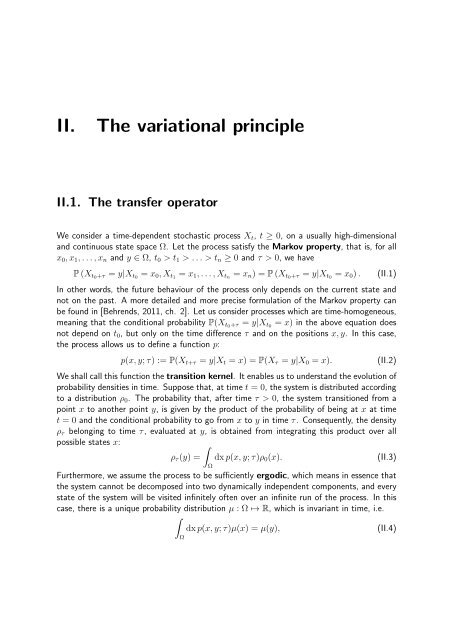Variational Principles in Conformation Dynamics - FU Berlin, FB MI
Variational Principles in Conformation Dynamics - FU Berlin, FB MI
Variational Principles in Conformation Dynamics - FU Berlin, FB MI
- No tags were found...
You also want an ePaper? Increase the reach of your titles
YUMPU automatically turns print PDFs into web optimized ePapers that Google loves.
II.The variational pr<strong>in</strong>cipleII.1. The transfer operatorWe consider a time-dependent stochastic process X t , t ≥ 0, onausuallyhigh-dimensionaland cont<strong>in</strong>uous state space Ω. LettheprocesssatisfytheMarkov property, thatis,forallx 0 ,x 1 ,...,x n and y ∈ Ω, t 0 >t 1 >...>t n ≥ 0 and τ>0, wehaveP (X t0 +τ = y|X t0 = x 0 ,X t1 = x 1 ,...,X tn = x n )=P (X t0 +τ = y|X t0 = x 0 ) .(II.1)In other words, the future behaviour of the process only depends on the current state andnot on the past. A more detailed and more precise formulation of the Markov property canbe found <strong>in</strong> [Behrends, 2011, ch. 2]. Letusconsiderprocesseswhicharetime-homogeneous,mean<strong>in</strong>g that the conditional probability P(X t0 +τ = y|X t0 = x) <strong>in</strong> the above equation doesnot depend on t 0 ,butonlyonthetimedifferenceτ and on the positions x, y. Inthiscase,the process allows us to def<strong>in</strong>e a function p:p(x, y; τ) :=P(X t+τ = y|X t = x) =P(X τ = y|X 0 = x).(II.2)We shall call this function the transition kernel. Itenablesustounderstandtheevolutionofprobability densities <strong>in</strong> time. Suppose that, at time t =0,thesystemisdistributedaccord<strong>in</strong>gto a distribution ρ 0 .Theprobabilitythat,aftertimeτ>0, thesystemtransitionedfromapo<strong>in</strong>t x to another po<strong>in</strong>t y, isgivenbytheproductoftheprobabilityofbe<strong>in</strong>gatx at timet =0and the conditional probability to go from x to y <strong>in</strong> time τ. Consequently,thedensityρ τ belong<strong>in</strong>g to time τ, evaluatedaty, isobta<strong>in</strong>edfrom<strong>in</strong>tegrat<strong>in</strong>gthisproductoverallpossible states x:ρ τ (y) = dx p(x, y; τ)ρ 0 (x).(II.3)ΩFurthermore, we assume the process to be sufficiently ergodic, whichmeans<strong>in</strong>essencethatthe system cannot be decomposed <strong>in</strong>to two dynamically <strong>in</strong>dependent components, and everystate of the system will be visited <strong>in</strong>f<strong>in</strong>itely often over an <strong>in</strong>f<strong>in</strong>ite run of the process. In thiscase, there is a unique probability distribution µ :Ω→ R, whichis<strong>in</strong>variant<strong>in</strong>time,i.e.dx p(x, y; τ)µ(x) =µ(y),(II.4)Ω









